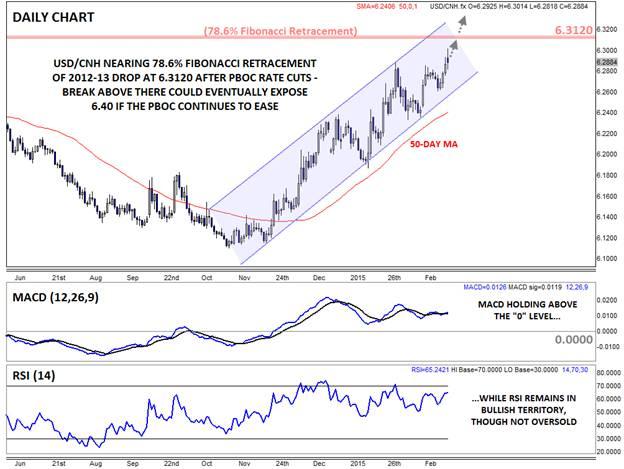![]()
It’s been an interesting start to what promises to be a interesting week in the FX market. The biggest story of Monday’s trade thus far has been the continued strength of the dollar despite disappointing data in the world’s largest economy. European currencies, including the Swiss franc and British pound, are getting hit particularly hard against the greenback.
hifting gears to the EM world, traders are still trying to digest the PBOC’s surprise rate cut over the weekend. With economic activity slowing in the world’s 2nd-largest economy, the PBOC opted to cut its both its lending rate and deposit rate by 0.25% to 5.35% and 2.5% respectively. In addition, the central bank has allowed the Chinese yuan to drop to its lowest level against the dollar since late 2012. Beyond the direct economic impact of the rate cuts, the PBOC’s actions signal that the central bank stands ready to support the Chinese economy with further easing later this year if needed. Thus far, neither developed (AUD and NZD) nor emerging (ZAR, SGD, THB) have found much solace in the PBOC’s support, but if we start to see Chinese economic data improve in response, those currencies may finally finds some support against King Dollar.
Technical View: USDCNH
As we’ve noted before, the Chinese yuan is not a completely free-floating currency. Instead, the People’s Bank of China (PBOC) sets a “central parity rate” against a basket of world currencies (primarily the U.S. Dollar), and the currency is allowed to oscillate within a 2% band around that level. For reference, the PBOC set today’s central parity rate at 6.1513, meaning that it will allow the currency to fluctuate between 6.00 and 6.30. Because of this so-called “managed float” regime, the efficacy of traditional technical analysis is limited, though it can still help traders identify relevant trends and key levels within the trading band.
USDCNH has been quietly putting in higher highs and higher lows since Q4, forming a clear bullish channel over that period. AS of writing the pair is in the middle of that channel, with more room up to the 78.6% Fibonacci retracement of the 2012-2013 drop at 6.312 if the central parity rate continues to nudge higher. Meanwhile, the secondary indicators are generally supportive, with the MACD and RSI both in bullish territory, but not overbought.
From here, the path of least resistance for USDCNH remains to the topside for a possible test of 6.3120 next. If that level is eclipsed (and especially if the PBOC is forced to cut interest rates further) an eventual move up toward 6.40 could be in play. At his point, only a reversal below the bullish channel and 50-day MA around 6.25 would shift the bias back to the downside.

Information on these pages contains forward-looking statements that involve risks and uncertainties. Markets and instruments profiled on this page are for informational purposes only and should not in any way come across as a recommendation to buy or sell in these assets. You should do your own thorough research before making any investment decisions. FXStreet does not in any way guarantee that this information is free from mistakes, errors, or material misstatements. It also does not guarantee that this information is of a timely nature. Investing in Open Markets involves a great deal of risk, including the loss of all or a portion of your investment, as well as emotional distress. All risks, losses and costs associated with investing, including total loss of principal, are your responsibility. The views and opinions expressed in this article are those of the authors and do not necessarily reflect the official policy or position of FXStreet nor its advertisers. The author will not be held responsible for information that is found at the end of links posted on this page.
If not otherwise explicitly mentioned in the body of the article, at the time of writing, the author has no position in any stock mentioned in this article and no business relationship with any company mentioned. The author has not received compensation for writing this article, other than from FXStreet.
FXStreet and the author do not provide personalized recommendations. The author makes no representations as to the accuracy, completeness, or suitability of this information. FXStreet and the author will not be liable for any errors, omissions or any losses, injuries or damages arising from this information and its display or use. Errors and omissions excepted.
The author and FXStreet are not registered investment advisors and nothing in this article is intended to be investment advice.
Recommended Content
Editors’ Picks
EUR/USD regains traction, recovers above 1.0700

EUR/USD regained its traction and turned positive on the day above 1.0700 in the American session. The US Dollar struggles to preserve its strength after the data from the US showed that the economy grew at a softer pace than expected in Q1.
GBP/USD returns to 1.2500 area in volatile session

GBP/USD reversed its direction and recovered to 1.2500 after falling to the 1.2450 area earlier in the day. Although markets remain risk-averse, the US Dollar struggles to find demand following the disappointing GDP data.
Gold climbs above $2,340 following earlier drop

Gold fell below $2,320 in the early American session as US yields shot higher after the data showed a significant increase in the US GDP price deflator in Q1. With safe-haven flows dominating the markets, however, XAU/USD reversed its direction and rose above $2,340.
XRP extends its decline, crypto experts comment on Ripple stablecoin and benefits for XRP Ledger

Ripple extends decline to $0.52 on Thursday, wipes out weekly gains. Crypto expert asks Ripple CTO how the stablecoin will benefit the XRP Ledger and native token XRP.
After the US close, it’s the Tokyo CPI

After the US close, it’s the Tokyo CPI, a reliable indicator of the national number and then the BoJ policy announcement. Tokyo CPI ex food and energy in Japan was a rise to 2.90% in March from 2.50%.